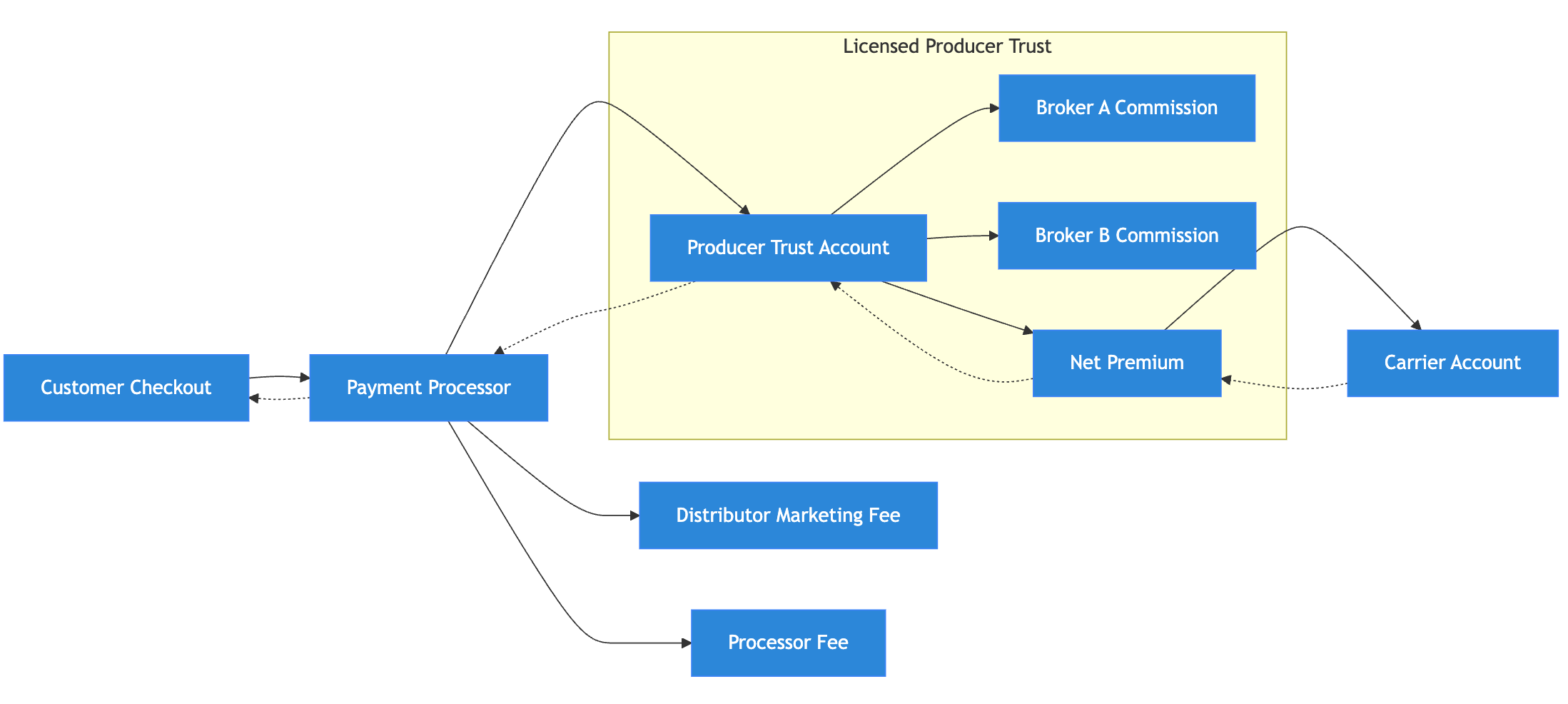Every dollar in an insurance transaction needs to follow the right path. If something goes sideways, regulators will want answers.
Selling insurance online isn’t only about speed and experience. It’s about building trust into the system from the start. If a customer complains or a carrier filing raises questions, your ability to show exactly where the money went and why it went there can make all the difference between momentum and a stall-out in digital growth.
Picture this: an embedded offer inside an online retailer’s existing checkout flow. The retailer isn’t a licensed producer, so premium dollars should not touch their bank account. Yet the processing fees still need paying, the broker still earns commission, the carrier needs net premium, and the retailer wants its marketing fee. When and how each slice lands matters just as much as who receives it, and you’ll still need to show a clear audit trail if regulators request it. A quick search turns up plenty of headlines about seven-figure fines when premium lands in the wrong account.
Thrusters Fail: A Cautionary Tale from Interplanetary Insurance
It’s a tale as old as stardust. OrbitMart, an established e-commerce outpost for off-world gadgets, adds a $7.99 “Zero-G Shield” policy from Interplanetary Insurance to every checkout. Launch weekend goes stellar, 5,000 micro-policies sold before the first cup of recycled coffee!
Then the money jets start to sputter.
Returns spike as 243 space-tourists send back faulty LunarPods™ and want their premiums refunded. Because OrbitMart, unlicensed to handle insurance funds, had built a DIY checkout and captured every dollar in its own merchant account, the platform can’t peel the insurance slice out of settled funds. Card processing fees are gone, broker commissions are already disbursed. The carrier is now scrambling to reconcile the whole mess, while customer support channels light up like solar flares.
Why Old Plumbing Won’t Cut It
The money rails and processes that power most insurance sales were designed for a slower world. Picture a neighborhood agent taking a paper check on Tuesday, dropping it at the bank on Wednesday, and sending the carrier its share a few days later. No one cared if the cash sat in limbo for a week; the customer never noticed.
Now drop that same setup into an instant-gratification online cart. The card processor moves all the money to the first bank account within hours, but insurance rules still expect it to pass through a trust account first. Because OrbitMart skipped that detour, it had no clean way to split refunds, fees, and commissions after the fact, turning a smooth launch into a bookkeeping black hole.

A Flow of Funds Built for the Future
When you strip away the sci-fi veneer, a future-proof flow of funds comes down to five practical capabilities:
- Split the premium at the payment processor. Insurance dollars should bypass any account that isn’t covered by a producer license—no detours, no manual sweeps.
- Close the books weekly—or faster. Built-in reconciliation should surface mismatches in days, not at month-end, so ops teams stay ahead of disputes and refunds.
- Carry 50-state producer licenses. The proper licensing is required for your embedded offer to go live nationwide.
- Stay processor-agnostic. Whether you use a legacy processor, tech-forward processor, or home-grown rails, the flow should bolt on without rebuilding the cart from the ground up.
- Push payouts downstream automatically. Commissions and marketing fees should land in broker and marketplace accounts on schedule, with a ledger everyone can audit.
Buddy’s flow-of-funds engine checks all five boxes—letting carriers and merchants plug in and launch embedded offers in weeks instead of quarters.

Put those five pieces together and you get something OrbitMart never had: money that lands in the right account on day one, reconciles itself by Friday, and refunds cleanly if a customer changes their mind a day later.
Curious how your rocket ship stacks up?
Run this Monday-morning checklist before your next launch window.
▢ Map every dollar from checkout to carrier. Draw a simple swim-lane diagram if you haven’t already.
▢ Confirm producer licensing for every product–state combo, and block sales where coverage is missing.
▢ Validate remittance clocks at least monthly.
▢ Stress-test refunds and chargebacks: can you reverse the flow with one click and an audit trail?
▢ Assign a single reconciliation owner, and equip them with software not spreadsheets.
Nail these five checks and you’ll avoid OrbitMart’s flame-out, and keep your growth trajectory pointing skyward.
A flawless launch selling insurance online isn’t just about beautiful buttons; it’s about making sure your flow of funds is built to regulatory spec and beyond. Map your flow, patch the gaps, and you’ll turn compliance drag into rocket fuel for growth.
Need a co-pilot? Buddy’s already charted the course.


